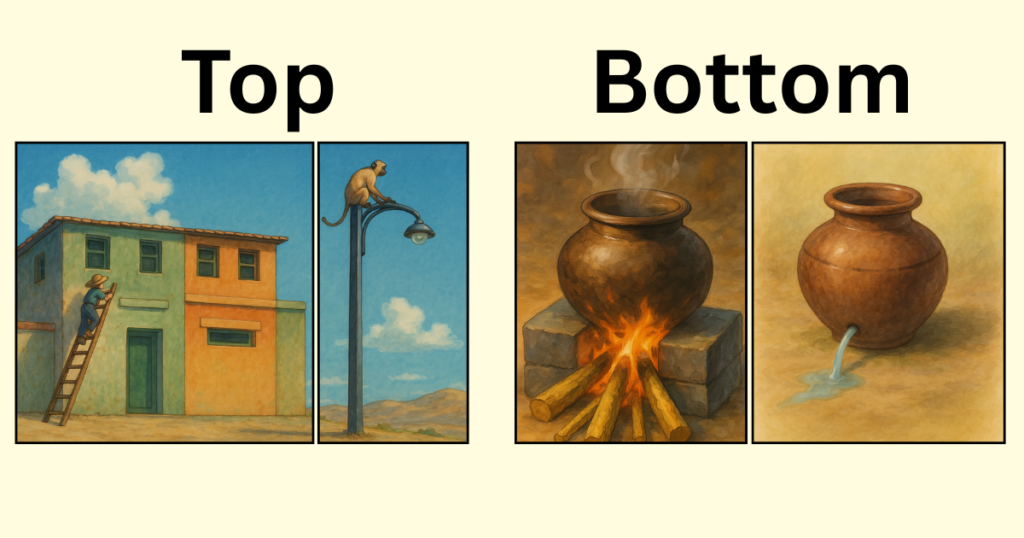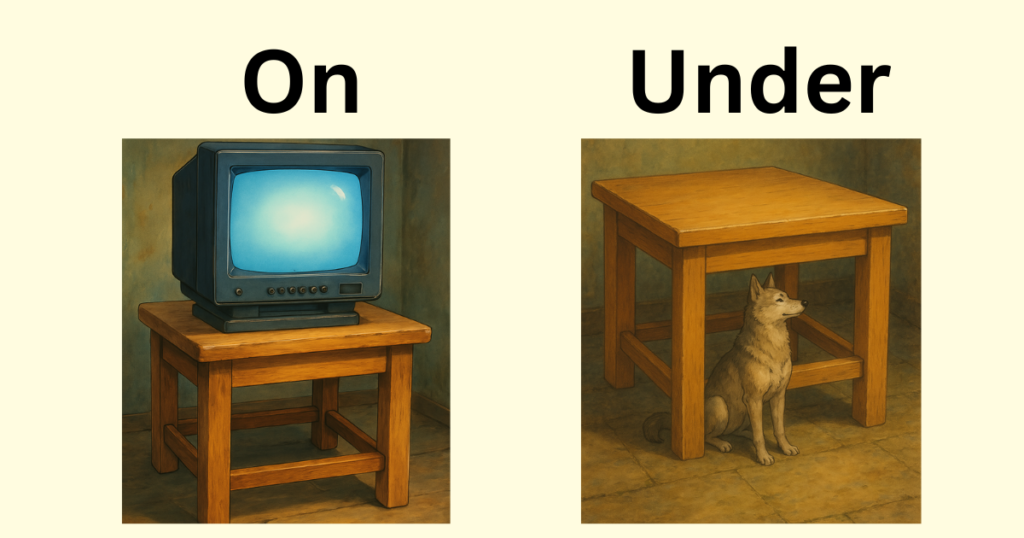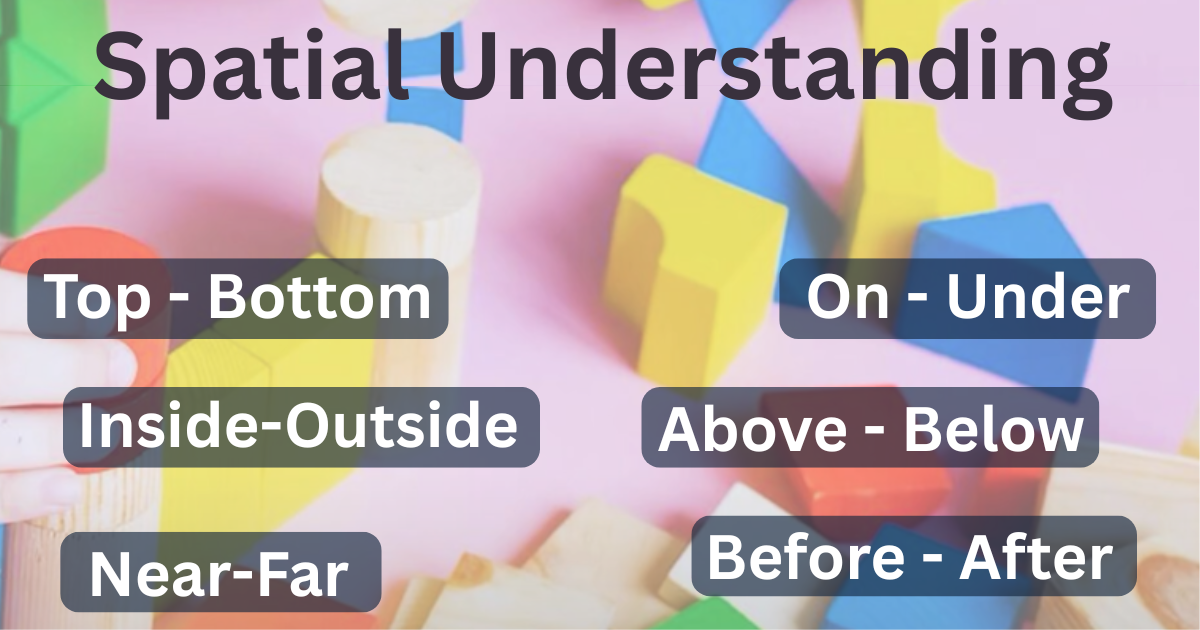Hello, my little explorers! Today, we’re going to learn about where things are placed around us. Have you ever wondered how we tell if something is on top or below, inside or outside? Let’s make this fun and easy!
Top and Bottom
Think about a tall tree. Where do the birds sit? Yes! They sit at the top of the tree. And where do the roots grow? At the bottom!
- The flower grows at the top of the plant.
- The pot sits at the bottom of the plant.
- Anant is painting at the top of the building.
- The fire touches the bottom of the pot.
Can you look around and find something at the top and something at the bottom?

On and Under
Now, imagine your table at home. What do you see on it? Maybe a book, a toy, or a plate? And what is under it? Maybe your pet or your shoes!
- The television is on the table.
- The dog is under the table.
- The mat is on the floor.
- The river flows under the bridge.
Can you place your hand on your head? Now, put it under your chin. See how easy that is?

Inside and Outside
Do you sleep inside your house? And where do you play? Outside!
- The fruits are inside the basket.
- The leaves are outside the basket.
- Mother is inside the house.
- Father is outside the house.
Try this: Take a toy and place it inside a box. Now, take it outside. You just practiced spatial words!
Above and Below
Look up! What do you see? Maybe a ceiling or the sky. That’s above you! Now, look down. That’s below you.
- The nose is above the mouth.
- The mouth is below the nose.
- A lamp is above the table.
- The table is below the lamp.
Can you spot something above your head right now? What about something below your chair?
Near and Far
Your best friend sits near you in class, but the school gate is far from your desk.
- The bird is near the tree.
- The moon is far from us.
- The sheep is near the pond.
- Ravi is standing near the swing, but Mary is far from it.
Try this: Take a step near a wall. Now, move far away from it. That’s how we understand distance!
Before and After
We do things in order every day. We wash our hands before eating and brush our teeth after waking up.
- Wash the mango before eating.
- Eat the mango after washing.
- Light the candle after placing it on the table.
What do you do before going to bed? What do you do after waking up? Think about it!
FAQs
1. How can I remember these words easily?
You can practice by looking at objects around you and using these words. Try making a game with your friends!
2. Why is it important to learn these words?
These words help us describe where things are, making it easy to talk about the world around us.
3. Can I practice this at home?
Yes! Ask your parents to help you find things on, under, near, and far from you.
4. What if I forget some words?
That’s okay! Keep practicing. Use toys, books, and even your hands to point and say the words aloud.
Keep learning and exploring, little champs! The world around you is full of fun things to discover!
Take assessment:
1. Multiple-Choice Questions (MCQs)
Example:
- Where is the bird sitting?
a) Under the tree
b) On top of the tree
c) Inside the tree
d) Far from the tree - The mat is ______ the floor.
a) under
b) on
c) inside
d) near
2. Fill in the Blanks
Example:
- The dog is ______ the table.
- The moon is ______ from the earth.
- The lamp is ______ the table.
- We eat food ______ washing our hands.
3. True or False
Example:
- The river flows above the bridge. (True / False)
- The flower is at the top of the plant. (True / False)
- The television is under the table. (True / False)
- The nose is below the mouth. (True / False)
4. Matching Questions
Match the words in Column A with the correct pair in Column B.
| Column A | Column B |
| Top | Floor |
| Under | Above the tree |
| Inside | Basket |
| Near | Far away |
5. Identify the Picture
Provide pictures of objects placed above, below, on, under, inside, outside, near, and far. Ask the child to circle or tick the correct position based on the description.
6. Sentence Formation
Example:
Use the words on, under, inside, outside, before, after to form meaningful sentences.
7. Arrange in Order (Sequencing Questions)
Example:
Arrange the following actions in the correct order:
- Eat the mango.
- Wash the mango.
Correct Answer:
- Wash the mango before eating.
8. Answer in One Word
Example:
- Where do birds sit in a tree? ______
- What is below your nose? ______
- Where do we keep fruits in a basket? ______
9. Think and Answer (Application-Based Questions)
Example:
- Look around your classroom. Name one object that is on something and one object that is under something.
- If your mother is inside the house and your father is outside, how will you describe their positions?
- If you see a ball near you and another ball far away, how will you describe them?
10. Draw and Label
Ask the child to:
- Draw a house and show something inside and something outside the house.
- Draw a tree and mark the top and bottom of it.
- Draw a table and show an object on and under it.

